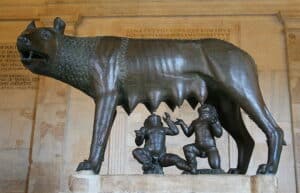The triumphal arches
There is also the Arch of Constantine, which is classified as one of the Triumphal Arches of Rome.
The other 2 Triumphal Arches are: Arch of Titus and Arch of Septimius Severus. The fourth Arch – Arch of Janus – is not considered triumphal.
Arch of Septimius Severus. The fourth Arch – Arch of Janus – is not considered triumphal.
Triumphal Arches are those built to celebrate a triumph, that is, when victory in a war was achieved.
Around AD 300, the Roman Empire was divided: Constantine I was emperor of Gaul, Brittany and Hispania, while Maxentius was the emperor of Rome.
In 312 AD Constantine I defeated Maxentius, the battle took place on the Milvian Bridge, the victory of Constantine’s heroic gestures are sculpted in the Arch that took his name.
The Arch of Constantine is located next to the Colosseum and in front of the access to the Via Sacra of the Roman Forum, that is, the arch is positioned exactly where parades of the triumphs of the conquests in Ancient Rome were held.
These parades ended with a celebration at Campidoglio. Thus, in 315 AD, the Roman Senate built the arch in honor of Constantine I’s victory over Maxentius.

During the Middle Ages, the arch was located on one of the roads that were “mandatory” passage for everyone who circulated through the Center of Rome. It was only from the 16th century that the arch was restored several times, making it as remarkable as before.
The Arch of Titus
After the Arch of Constantine, we can go through the Via Sacra, pass through the street of pears with the old pavement and we arrive at the Roman Forum, where we are welcomed by the imposing Arch of Titus.
Titus sacked and conquered Jerusalem and returned to Rome in the year A.D. 71. He used all the money looted from Jerusalem to build the arch.
With the death of Titus in 81 CE, the Roman Senate started to consider him as a “god”, being attributed the immortality of the great emperors by placing the following inscription in his triumphal arch:
“SENATUS POPULUSQUE ROMANUS DIVO TITO DIVI VESPASIANI F(ILIO) VESPASIANO AUGUSTO” which means: The Senate and the Roman people to the divine Titus, son of the divine Vespasian, Vespasian Augustus.

Roman Forum
After admiring the Arch of Titus, we go to the ruins of the Roman Forum and the Palatine, which form a spectacular archaeological area.
Approximately in 600 BC, the king of Rome was Tarquinius, of Etruscan origin. Tarquinius had the area drained because it was considered a mangrove region and thus built the Cloaca Maxima, considered the largest sewer network in Ancient Rome to date.
Currently, we find the ruins of the Temple of Vesta (goddess of the house and the family environment) and where there is a sign with words indicating exactly where the Cloaca Maxima would be.
The area brought together the religious, political, financial, commercial and legal center of Rome, for that reason it was called Forum Magnum, better known as Forum.
It was in the Republican and Imperial periods that the forum grew and developed, as they were built:
- The Temple of Saturn – 5th century BC;
- The Temple of Concordia – 4th century BC;
- The Emilia Basilica – 2nd century BC
- And the Iulia Basilica – built by Julius Caesar

During each century, the Roman Forum increased in size, as each emperor left his mark.
However, in 607 AD his last monument was built in honor of Phocas (column of Phocas), emperor of the Eastern Roman Empire who presented the Pope with the Pantheon in Rome.
Pope with the Pantheon in Rome.
The Palatine
The Palatine has existed since prehistory, its entire evolution is narrated by the Palatine Museum. In the Palatine there are fewer ruins than the Roman Forum.
In it, the ruins are of imperial palaces where characters like Augusto, Calígula, Tiberius, Nero, lived.
Famous for being the place – according to legend – where the wolf suckled the twins Romulus and Remus.

Romulus founds Rome after murdering Remus (his brother).
At the top of the hill, there are 6 viewpoints, where it is possible to see the city from the top, you can see the Colosseum, the Dome of Santa Maria Maggiore, the Vittoriano coast. You can also see the Circus Maximus and the Tiber River. And also the Dome of St. Peter’s Basilica, in the Vatican.
To tour a virtual reconstruction through the Palatine and Roman Forum click on the image:
